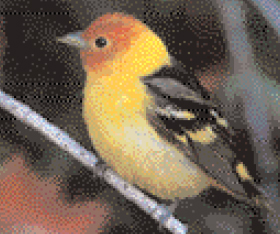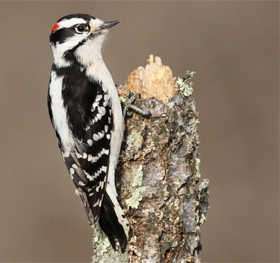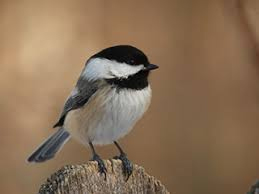
 Western
Tanager
Western
Tanager
The male Western
Tanager is one of the
most colorful birds
found in the west.
Summer welcomes
this delightful 7" bird to our area, although a few
may stay all year. The male has a red face and a
yellow belly. Their back, wings and tail are black.
They also have two bands of color on their wings.
The upper band is wider and yellow; the lower band
is thinner and white. The females are less colorful
as with most species. Females are camouflaged out
of necessity to resist being detected while on the
nest with eggs. The Tanager females are greenish
yellow and gray. They have brown wings with thin
white wing bars. Tanagers eat wasps and other
insects - often caught in midair. Halved oranges and
grapes may lure these birds to a feeder. They love
the Bottlebrush plant as do many nectar drinking
birds. They will come to birdbaths to bath and
drink. Their preferred habitat is in forest.

DOWNY
WOODPECKER
The Downy is the
smallest of the
North American
woodpeckers. It is
also the most
abundant and can be
found in the woods, the
suburbs and even in urban areas. It's success may
actually be due to it's small size. Being only 6 inches
long, enables the Downy to nest in spaces where it's
competitors and larger relatives are unable to fit. With a
thorn-like bill, it is able to chip away bark and feast on
spiders, ants, larvae, and insect egg masses. The males
and females dine on different areas of trees. The females
scour the trunk and larger limbs of a tree, while the
males feed on the smaller limbs. These diminutive
woodpeckers also like suet, shelled peanuts, peanut
butter, and cracked corn. In the spirit of co-operation, as
many as 60 individual birds might feed on one feeder -
visiting in rotation.
 CHICKADEES
CHICKADEES
Chickadees are
tiny - weighing on
1/3 to 1/2 ounce. Yet
they are often seen
claiming their spot on a feeder,
unintimidated by much larger birds. Because
agile, nimble and often hanging upside
miniature acrobats are a joy to watch. Constantly
movement, they are one the most familiar
of birds. Chickadees are warm- blooded
metabolisms so they are in constant need
Some favorites include insects - berries
sunflower seeds. With patience you might
that they are one of the few species that
to eat directly out of a person's hand.

Red
Tailed
Hawk
Raptor -
Bird of Prey
The most commonly seen Hawk, is a raptor that is seen
throughout North America. They are approximately
19-25 inches long, with a wingspan of 4 feet, and weigh
2-4 pounds. It gets its name from its broad rounded tail
which displays rich, russet red. There are 14 sub-species
of Red Tailed Hawks. They employ many hunting styles,
from hovering, diving, to sitting and waiting (for long
periods of time.) Long - sharp talons (claws) are its main
weapon. While its prey consist of rodents, skunks,
insects, snakes and lizards. Other birds make up about
10% of its diet - explaining why most small bird species
appear agitated when one is nearby. Red Tailed Hawks
are easily identified by their distinctive call - a scream
somewhat like "tseeaarr" slurring downward. Males and
females share duties of raising the young, which leave
the nest (usually 20-80 feet high in trees) after 30-60
days. They are often seen in our nearby open space.
 American
Goldfinch
American
Goldfinch
These are the bright yellow
birds at your feeders
enjoying nyger and sunflower
seeds. They are
about 4-5 inches long.
Male Goldfinch bodies
are bright yellow in the
summer - duller in the
winter. They sport a black cap on their heads and black
wings and tail with white tips and wing bars. Females
are less bright and have no cap. All have seed eating
bills. They nest in shrubs or trees about 4-20 feet above
the ground. The nests are made of weeds, vines, and the
downy filaments from wind-dispersed seeds, such as
thistles, bound with caterpillar webbing. They have
looping flights. During mating season it is done in an
exaggerated manner by the male, while he circles his
territory. The female builds the nest and may have a
second nest while her first young are fed by the male.
Their song is almost canary-like. They use a second
song while in flight. Goldfinches leave their breeding
territory in the winter and head south. They wander in
flocks in search of food. American Goldfinches are the
most frequently reported finch found at feeders.
 Ever wondered the
difference between
a crow and a raven?
Ever wondered the
difference between
a crow and a raven?
American Crow
Is all black and about 18 inches
long. They make the familiar
"caaw"sound. Their nests are high in trees and made of twigs
and sticks lined with bark, grass and moss. They "cache" or
hide food to consume later and have communal roosts -
which means they flock together. They have "helpers" at the
nest (offspring from previous years) that help defend the
territory and feed the young (babysitters). Their habitat is
across most of the U.S. - increasingly around cities and towns.
 Common Raven
Common Raven
Is all black, but much larger than the crow
- about 24 inches long with a massive bill.
They soar like a hawk. The males have
elaborate courtship maneuvers of steep
dives and tumble rolls. They also are
communal roosters in the fall and winter.
Their call is a "gronk." ARaven's habitat
is commonly in the mountains and forest -
where they build nests of bulky masses
of twigs and earth - mostly on cliffs but can be in trees.